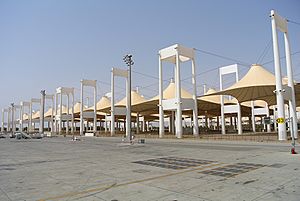Fazlur Rahman Khan facts for kids
Quick facts for kids
Fazlur Rahman Khan
|
|
|---|---|
| ফজলুর রহমান খান | |
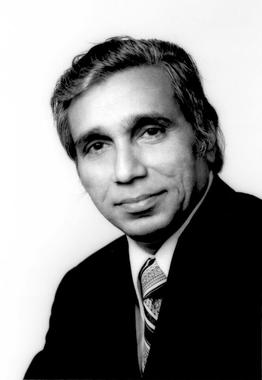
Fazlur Rahman Khan
|
|
| Born | 3 April 1929 |
| Died | 27 March 1982 (aged 52) |
| Resting place | Graceland Cemetery, Chicago |
| Nationality | British Indian (1929-1947) Pakistani (1947-1971) Bangladeshi (after 1971) American |
| Education | Armanitola Government High School Bengal Engineering and Science University, Shibpur Ahsanullah Engineering College (BSc) University of Illinois Urbana-Champaign (MS, PhD) |
| Occupation | Engineer |
| Spouse(s) | Liselotte Khan |
| Children | Yasmin Sabina Khan |
| Relatives | Abdul Jabbar Khan (sister's father-in-law) A.Z.M. Enayetullah Khan (brother-in-law) |
| Engineering career | |
| Discipline | Architectural, civil, structural |
| Significant design | John Hancock Center, Willis Tower, Hajj Terminal, King Abdulaziz University, One Magnificent Mile, Onterie Center |
| Awards | Aga Khan Award for Architecture, Independence Day Award, AIA Institute Honor for Distinguished Achievement |
Fazlur Rahman Khan (Bengali: ফজলুর রহমান খান; 3 April 1929 – 27 March 1982) was a brilliant Bangladeshi-American structural engineer and architect. He created important new ways to build skyscrapers. Many people call him the "father of tubular designs" for tall buildings. He was also a leader in using computer-aided design (CAD).
Khan designed the famous Sears Tower, now called the Willis Tower. This building was the world's tallest from 1973 to 1998. He also designed the 100-story John Hancock Center. As a partner at Skidmore, Owings & Merrill (SOM) in Chicago, Khan helped bring back skyscraper construction in the late 1900s. He is known as the "Einstein of structural engineering." His ideas are still key to modern skyscraper design and construction. The Council on Tall Buildings and Urban Habitat created an award in his honor. It is called the Fazlur Khan Lifetime Achievement Medal.
Even though he is famous for skyscrapers, Khan designed other structures too. These include the Hajj airport terminal and the McMath–Pierce solar telescope.
Contents
Who Was Fazlur Rahman Khan?
Early Life and Family Background
Fazlur Rahman Khan was born on April 3, 1929, in Dhaka, which was then part of British India. Today, Dhaka is the capital of Bangladesh. He grew up in a place called Bhandarikandi in Madaripur District. His father, Abdur Rahman Khan, was a mathematics teacher and textbook writer. His mother was Khadijah Khatun.
Education and Moving to America
Khan went to Armanitola Government High School in Dhaka. He then studied Civil Engineering in India and Bangladesh. He earned his Bachelor of Civil Engineering degree from Ahsanullah Engineering College. In 1952, he received scholarships to study in the United States.
He went to the University of Illinois at Urbana-Champaign. In just three years, he earned two master's degrees and a PhD in structural engineering. Interestingly, his hometown in Dhaka did not have any buildings taller than three stories. He saw his first skyscraper when he was 21 years old.
His ideas for tube buildings were inspired by the bamboo he saw growing around Dhaka. He noticed that a hollow tube, like bamboo, made a tall plant strong and durable.
Fazlur Khan's Amazing Career
Working at Skidmore, Owings & Merrill
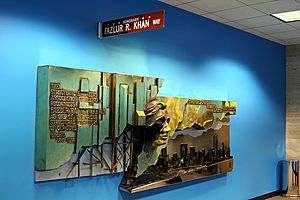
In 1955, Khan started working for the architecture firm Skidmore, Owings & Merrill (SOM) in Chicago. He became a partner in the firm in 1966. He worked closely with architect Bruce Graham for the rest of his life. Khan created new ways to design buildings that used materials very efficiently.
His first building to use a tube structure was the Chestnut De-Witt apartment building. During the 1960s and 1970s, he became well-known for his designs. These included Chicago's 100-story John Hancock Center and the 110-story Sears Tower (now Willis Tower). The Sears Tower was the world's tallest building from 1973 to 1998.
Khan believed that engineers should have a broad view of life. He said, "The technical man must not be lost in his own technology; he must be able to appreciate life, and life is art, drama, music, and most importantly, people."
Personal Life and Citizenship
Khan enjoyed singing poetic songs in Bengali by Rabindranath Tagore. He and his wife, Liselotte, had one daughter born in 1960. Liselotte had moved from Austria. In 1967, Khan became a citizen of the United States.
How Fazlur Khan Changed Skyscrapers
The "Tube" Idea for Tall Buildings
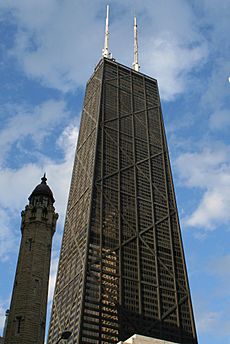
Khan's biggest idea for skyscraper design and construction was the "tube" structural system. This included different types like the framed tube, trussed tube, and bundled tube. His "tube concept" made the entire outer wall of a building act like a strong, hollow tube. This changed how tall buildings were designed.
Most buildings over 40 stories built since the 1960s use a tube design based on Khan's ideas. Tall buildings face strong horizontal forces like wind and earthquakes. These forces become very important as buildings get taller. Tube structures are stiff and resist these forces well.
They make buildings stronger and more efficient. They also use much less material, which saves money and helps the environment. Tube designs allow buildings to be built even taller. They also create more open space inside and let architects design buildings in many different shapes. These new designs made it possible to build huge amounts of real estate on small plots of land.
Khan was a key figure in bringing back skyscraper construction after many years. The tube systems can still be used for even taller buildings. Another great thing about them is that buildings can be made from steel, concrete, or a mix of both. Khan also led the way in using lightweight concrete for high-rise buildings. Before him, concrete was mostly for shorter buildings.
Khan designed many of his buildings so that parts could be made in factories and put together easily. This made construction faster and reduced mistakes. The world's population grew a lot starting in the 1950s. This made people worry about having enough living space. Khan helped solve this by making it possible to build upwards.
Mark Sarkisian, a director at SOM, said Khan "transformed skyscrapers into sky cities."
Different Types of Tube Structures
Framed Tube Buildings
Since 1963, the framed tube system became very popular. Khan described it as a 3D structure made of frames or walls joined at the edges. This forms a vertical tube that can resist forces from any direction. Closely spaced columns on the outside form the tube.
Horizontal forces like wind are handled by the whole structure. About half of the outside can have windows. Framed tubes need fewer columns inside, creating more usable floor space. The first building to use this was the DeWitt-Chestnut Apartment Building in Chicago in 1963. This idea was later used for the World Trade Center.
Trussed Tube and X-Bracing
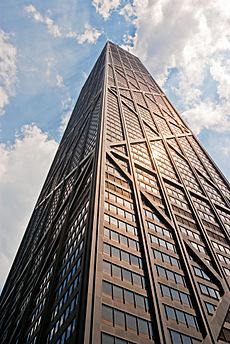
Khan also created other tube designs. One was the trussed tube, which uses X-bracing on the outside. X-bracing helps the building resist side forces by sending the load to the outer columns. This means fewer inside columns are needed, giving more usable space.
Khan first used exterior X-bracing on the John Hancock Center in 1965. You can clearly see these X-braces on the building's outside, making it famous. The John Hancock Center used much less steel than older skyscrapers. This design was later used in many other tall buildings.
Bundled Tube Design
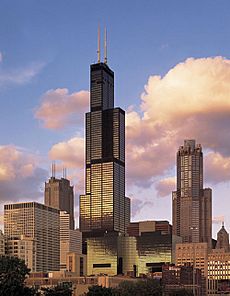
One of Khan's most important tube ideas was the bundled tube. This was used for the Willis Tower and One Magnificent Mile. The bundled tube design was very efficient and allowed for creative building shapes. Towers no longer had to be simple boxes. Different tube units could be grouped together in various ways.
Tube-in-Tube System
The tube-in-tube system uses a central core wall (inner tube) along with the outer tube. Both tubes work together to support the building's weight and resist side forces. This makes the building very stiff and prevents too much swaying at the top. This design was first used in One Shell Plaza. The Petronas Towers also use this system.
Outrigger and Belt Truss System
The outrigger and belt truss system helps buildings resist side forces. It connects the outer tube structure to the central core wall with very strong "outriggers" and "belt trusses." These are placed at one or more levels. The BHP House was the first building to use this. The U.S. Bank Center in Milwaukee also uses this system. Its exposed belt trusses are both beautiful and structural.
Concrete Tube Structures
Khan's last major buildings, One Magnificent Mile and Onterie Center, used his tube systems but were made of concrete. His earlier DeWitt-Chestnut Apartments building (1963) was also a concrete tube structure. Trump Tower in New York City is another example of this system.
Shear Wall Frame Interaction System
Khan also created the shear wall frame interaction system for mid-rise buildings. This system combines strong walls (shear walls) and frames to resist side forces. The 35-story Brunswick Building, completed in 1965, was the first to use this. It became the tallest reinforced concrete building of its time. This idea has been used successfully in apartment buildings up to 70 stories high.
Khan's Lasting Impact
Khan's groundbreaking work on tall building structures is still the starting point for designing skyscrapers today. Tube structures have been used in many famous buildings. These include the World Trade Center, Aon Center, Petronas Towers, Jin Mao Building, and Bank of China Tower. Most buildings over 40 stories built since the 1960s use his ideas. The world's tallest skyscraper, the Burj Khalifa in Dubai, also shows the strong influence of his tube design.
Protecting Buildings from Earthquakes
Khan and Mark Fintel had ideas for "shock absorbing soft-stories." These would protect structures from unusual forces, especially strong earthquakes. This was an early idea for modern seismic isolation systems. These systems allow buildings to move naturally during an earthquake. This protects the building's materials from damage.
The International Association for Life Cycle Civil Engineering (IALCCE) created the Fazlur R. Khan Life-Cycle Civil Engineering Medal in his honor.
Other Amazing Designs by Khan
Khan designed several other important structures that were not skyscrapers. One example is the Hajj terminal at King Abdulaziz International Airport, finished in 1981. It has unique tent-like roofs that can be folded up when not in use. This project won several awards, including the Aga Khan Award for Architecture. It was praised for its "outstanding contribution to architecture for Muslims." These tent-like structures helped advance the use of fabric as a building material.
Khan also designed parts of King Abdulaziz University and the United States Air Force Academy. He also worked on the Hubert H. Humphrey Metrodome in Minneapolis. With Bruce Graham, he developed a special cable-stayed roof system for the Baxter Travenol Laboratories.
Computers in Engineering and Architecture
In the 1970s, engineers were just starting to use computers for structural analysis. SOM was a leader in this, thanks to Khan's help. Graham and Khan convinced SOM partners to buy a large computer. This was a risky step at the time. Khan then programmed the system to solve engineering equations. Later, it was used to create architectural drawings.
Key Projects and Recognition
Buildings Engineered by Khan
Here are some of the buildings where Fazlur Khan was the structural engineer:
- McMath–Pierce solar telescope, Kitt Peak National Observatory, Arizona, 1962
- DeWitt-Chestnut Apartments, Chicago, 1963
- Brunswick Building, Chicago, 1965
- John Hancock Center, Chicago, 1965–1969
- One Shell Square, New Orleans, Louisiana, 1972
- 140 William Street (formerly BHP House), Melbourne, 1972
- Sears Tower, renamed Willis Tower, Chicago, 1970–1973
- First Wisconsin Center, renamed U.S. Bank Center, Milwaukee, 1973
- Hajj Terminal, King Abdulaziz International Airport, Jeddah, 1974–1980
- King Abdulaziz University, Jeddah, 1977–1978
- Hubert H. Humphrey Metrodome, Minneapolis, Minnesota, 1982
- One Magnificent Mile, Chicago, completed 1983
- Onterie Center, Chicago, completed 1986
- United States Air Force Academy, Colorado Springs, Colorado
Awards and Honors
Khan received many awards for his work. These include the Wason Medal and Alfred Lindau Award. He also received the Thomas Middlebrooks Award and the Ernest Howard Award. He was given the Kimbrough Medal and the Oscar Faber medal. In 1983, he received the International Award of Merit in Structural Engineering. The American Institute of Architects gave him an honor for Distinguished Achievement.
Engineering News-Record (ENR) mentioned Khan five times for helping the construction industry. In 1972, he was named ENR's Man of the Year. In 1973, he was elected to the National Academy of Engineering. He also received honorary doctorates from several universities.
The Council on Tall Buildings and Urban Habitat named an award after him: the Fazlur Khan Lifetime Achievement Medal. There is also a special teaching position at Lehigh University called the Fazlur Rahman Khan Endowed Chair. This honors his legacy in engineering and architecture.
President Barack Obama mentioned Khan in a 2009 speech. He highlighted Khan's achievements as an American Muslim citizen. On April 3, 2017, Google honored Khan with a Google Doodle for his 88th birthday.
Documentary Film About Khan
In 2021, a documentary film about Khan's life began production. It is called Reaching New Heights: Fazlur Rahman Khan and the Skyscraper. The film is being made by Laila Kazmi's company, Kazbar Media.
Helping Others During War
In 1971, the Bangladesh Liberation War started. Khan worked hard to raise awareness and emergency money for the people of Bengal. He created an organization in Chicago called the Bangladesh Emergency Welfare Appeal.
Death and Burial
Fazlur Rahman Khan passed away from a heart attack on March 27, 1982. He was 52 years old and was on a trip in Jeddah, Saudi Arabia. His body was brought back to the United States. He is buried in Graceland Cemetery in Chicago.
See also
 In Spanish: Fazlur Rahman Khan para niños
In Spanish: Fazlur Rahman Khan para niños
- Chicago school
- Engineering Legends, a 2005 book
- List of Bangladeshi architects
Images for kids


